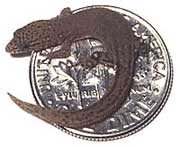The littlest lizard

Turn on a dime: the Jaragua lizard. <br>© S.B. Hedges <br>
World’s smallest reptile is discovered in the Caribbean forest.
At just 16 mm from nose to tail, the Jaragua lizard is the world’s smallest. In fact, it’s the smallest vertebrate that can reproduce on dry land1.
The newly discovered lizard lives on Isla Beata, a small, forest-covered island in the Caribbean off the Dominican Republic. Blair Hedges, an evolutionary biologist at Pennsylvania State University, together with Richard Thomas of the University of Puerto Rico, San Juan, found the lizard in three sites, including one at the very southern tip of mainland Dominica. The researchers believe the lizard lives only in these areas.
The Jaragua (Sphaerodactylus ariasae) may be about as small as a land vertebrate – the 23,000 species of reptiles, birds and mammals – can get. Smaller animals have a proportionately greater surface area, making them more vulnerable to drying out. Another biological size limit could be the minimum size needed for a functioning nervous system, suggests Aaron Bauer, who studies reptiles at Villanova University, Pennsylvania.
Bauer thinks that other tiny lizards are probably out there – one of a similar size is known from the British Virgin Islands. But Hedges believes that the Jaragua will hold its record for some time. “It’s not likely we’ll encounter a smaller one next year,” he says.
Small is beautiful
The Caribbean is also home to the world’s smallest bird, frog and snake. Michael Smith, of Conservation International in Washington DC, thinks that diminutive animals could become the poster children for the region’s wildlife.
“The Caribbean doesn’t have large, charismatic species. But we could turn the idea on its head, and make these unique elements of biodiversity icons of conservation,” says Smith, an expert on Caribbean biodiversity.
Such icons are sorely needed. Only 10% of the Caribbean’s original forests remain, and a wave of extinction may soon hit the region. “We’re going to have losses, it’s just a matter of time,” Smith says.
Despite this, he is optimistic for the Jaragua lizard’s prospects. Isla Beata is part of a national park, and local people have formed conservation organizations. The park’s remoteness and ruggedness give further protection.
Giant pigeons, pygmy elephants
Islands are natural evolutionary laboratories. Their isolation means that the creatures that do wash up, perhaps clinging to floating vegetation, have less competition, and can evolve to do ecological jobs that are already taken on the mainland.
In the Jaragua lizard’s case, it has downsized to “live like an insect”, says Bauer. It feeds on small insects, and must be on guard against being eaten by centipedes and scorpions.
Island species are often unusually large or small. Mauritius’ dodo, for example, was an overgrown pigeon, while the ancient inhabitants of Crete included a pygmy elephant and hippopotamus.
References
- Hedges, S. B., Thomas, R. At the lower size limit in amniote vertebrates: a new diminutive lizard from the West Indies. Caribbean Journal of Science, 37, 168 – 173, (2001).
Media Contact
All latest news from the category: Life Sciences and Chemistry
Articles and reports from the Life Sciences and chemistry area deal with applied and basic research into modern biology, chemistry and human medicine.
Valuable information can be found on a range of life sciences fields including bacteriology, biochemistry, bionics, bioinformatics, biophysics, biotechnology, genetics, geobotany, human biology, marine biology, microbiology, molecular biology, cellular biology, zoology, bioinorganic chemistry, microchemistry and environmental chemistry.
Newest articles
Faster, more energy-efficient way to manufacture an industrially important chemical
Zirconium combined with silicon nitride enhances the conversion of propane — present in natural gas — needed to create in-demand plastic, polypropylene. Polypropylene is a common type of plastic found…

Energy planning in Ghana as a role model for the world
Improving the resilience of energy systems in the Global South. What criteria should we use to better plan for resilient energy systems? How do socio-economic, technical and climate change related…

Artificial blood vessels could improve heart bypass outcomes
Artificial blood vessels could improve heart bypass outcomes. 3D-printed blood vessels, which closely mimic the properties of human veins, could transform the treatment of cardiovascular diseases. Strong, flexible, gel-like tubes…




















